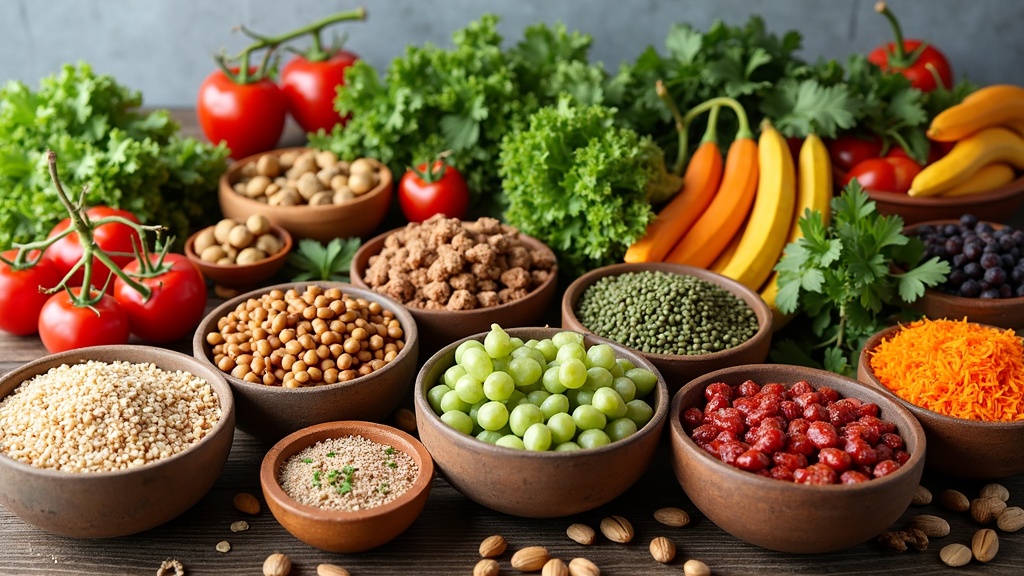Switching to a plantbased diet often sounds like a simple swap—less meat, more plants—until you actually try it.
The reality? There are a few bumps in the road that people don’t always talk about.
I’ve tried transitioning to plantbased myself, and I ran into some of these challenges firsthand.
The good thing is, with a bit of planning, the process can be a whole lot smoother.

Getting Familiar With PlantBased Eating
Moving from a meatheavy diet to a plantbased one changes the way you shop, cook, and even dine out.
There’s a pretty big switch up in what ends up on your plate, so the early phase is all about figuring things out.
Plantbased diets focus mainly on fruits, vegetables, whole grains, legumes, nuts, and seeds.
There’s a lot of flexibility; some folks cut out all animal products, while others hang on to a bit of dairy or fish.
What’s important is making food choices that match up with your personal health goals and preferences.
Interest in plantbased eating keeps growing. According to The Good Food Institute,
plantbased foods are now a multibillion dollar industry, reflecting changes in how people approach their meals and nutrition around the world.
You can even find plantbased options in fast food chains, making this lifestyle more accessible and mainstream.
Typical Hurdles When Switching to PlantBased
Transitioning to a plantbased diet often comes with some challenges, whether you’re trying to improve your health, help the environment, or just want to try something new. Here’s what I—and many others—have faced:
- Meal Planning Confusion: Figuring out what to eat and how to build a satisfying meal.
- Cravings and Emotional Attachments: Missing the taste or comfort foods from your old diet.
- Nutritional Concerns: Worrying about getting enough protein, iron, calcium, or B12 from plants.
- Eating Out and Social Situations: Not knowing what you can order or how to deal with questions from friends and family.
- Food Accessibility and Budget: Navigating price differences or finding the right ingredients.
Overcoming Meal Planning Confusion
The biggest struggle I had at first was just deciding what to eat.
Without the usual “meat, veg, and potatoes” formula, I felt a bit lost in the kitchen.
Creating balanced, filling meals takes a little more thought at the beginning.
- Start Simple: I found sticking to easy, familiar dishes helped; think veggie stirfries with tofu, chili with beans, or oatmeal with fruit. There’s no need to reinvent every meal all at once.
- Batch Cooking: Cooking big portions and freezing extras saved me from having to plan new meals every day. It also meant fewer lastminute takeout orders.
- Find Inspiration: I started using sites like Minimalist Baker for plantbased recipes that don’t require fancy ingredients or loads of time.
- Build a PlantBased Pantry: Stocking my kitchen with staples like canned beans, whole grains, pasta, and a range of spices made it easy to throw together quick meals without a lot of fuss.
Dealing With Cravings and Emotional Attachments
Saying goodbye to certain foods is more about expectations and emotions than actual hunger.
I missed pizza and burgers—not because of the nutrition, but because those foods had always been part of how I relaxed or celebrated with friends.
- Find PlantBased Alternatives: The good news is there are plantbased versions of almost everything now—pizza with cashew cheese, burgers made from beans or mushrooms, and nondairy ice creams that are pretty tasty. Swapping in these substitutes made the switch up easier for me.
- Change the Routine: Creating new traditions around plantbased treats helps. For example, now I have popcorn and homemade guacamole instead of cheeseladen nachos during movie nights.
- Be Gentle With Yourself: It’s normal to crave old favorites when changing habits. I found it helpful to allow for occasional treats, especially at first, so the adventure didn’t feel overwhelming.
Addressing Nutritional Concerns
Friends and family asked me how I got my protein or if I missed iron. These questions made me realize I needed to brush up on the best sources of key nutrients from plants, too.
- Protein: Beans, lentils, tofu, tempeh, soymilk, and quinoa all pack in a good amount of protein. I just make sure to include one or two at every meal.
- Iron: Foods like spinach, lentils, pumpkin seeds, and fortified cereals are solid choices. Eating them with vitamin Crich foods (like oranges or bell peppers) helps the body absorb iron better.
- B12 and Calcium: Fortified plant milks and cereals cover my bases for B12 and calcium. A supplement for B12 works for many people if you’re going allin on plantbased.
- Omega3s: Foods such as chia seeds, flaxseeds, and walnuts can offer plantbased omega3 fatty acids. Including these in your meals can support heart and brain health.
I’ve also used Eat Right as a reliable reference for plantbased nutrition advice.
Consulting a dietitian at least once can be helpful to make sure you’re on the right track, especially if you have specific health goals or dietary needs.
Managing Eating Out and Social Situations
Eating plantbased at home is one thing, but going to restaurants or family events brings up a whole new set of challenges.
Sometimes there are no plantbased options on the menu, and social gatherings often center around traditional favorites.
- Check Menus Ahead: Scoping out restaurant menus before I go means I know what I can order. Most places will tweak a dish if you ask nicely.
- Bring a Dish: Potlucks or holidays are easier when you show up with a crowdpleasing plantbased meal to share. It takes the pressure off and shows others how tasty plantbased can be.
- Talk About It: I found that sharing my reasons for switching and being positive about the experience helped friends and family understand, even if they didn’t totally “get it.”
- Practice Assertive Communication: When people ask questions or express curiosity, I keep the mood light and explain the changes without judging anyone else’s choices. This diffuses tension and often leads to friendly chats about food or cooking tips.
Controlling Food Costs and Accessibility
Some plantbased specialty products in stores can be pricier than standard groceries.
I’ve learned that stocking up on basics and cooking from scratch keeps costs down.
If you’re in an area with fewer specialty stores, focusing on staple ingredients ensures that plantbased eating remains practical and accessible.
- Stick to Whole Foods: Foods like dried beans, rice, oats, potatoes, carrots, and seasonal veggies are usually budgetfriendly and available almost anywhere.
- Shop Smart: Buying in bulk, shopping sales, and checking out local farmers markets often helps me save money on fresh produce and pantry staples.
- Frozen Is Fine: Frozen fruits and veggies are just as nutritious as fresh, a little cheaper, and won’t go bad quickly.
- Embrace Meal Planning: Planning your meals for the week cuts down on impulse buys and food waste, helping you stick to your budget.
What I’ve Learned: Practical Tips for Making the Switch Easier
Switching to plantbased is definitely a learning process. These strategies made the biggest difference for me:
- Pace Yourself: I switched out one meal at a time instead of throwing everything out at once. Gradual change helped me adjust and feel less overwhelmed.
- Stay Curious: I tried new foods or cuisines each week; there’s so much beyond salad or tofu once you start experimenting.
- Keep Some Favorites: Adapting my goto meals (like pasta or tacos) by swapping out meat with beans or lentils helped keep things familiar and comforting.
- Prep Snacks: Having cutup veggies, hummus, or trail mix around stopped me reaching for less healthy options when hungry.
- Find Support: Joining online groups or following plantbased creators added a social element that kept me motivated. Seeing others cook up creative meals provided tons of inspiration and accountability.
- Educate Yourself: Reading books or watching documentaries about plantbased nutrition and animal welfare gave me a deeper appreciation of the adventure. Understanding the “why” behind your choices can strengthen your resolve during tough days.
Questions I Hear Most Often About Going PlantBased
I get a lot of questions about the nuts and bolts of plantbased eating. Here are a few I hear all the time:
How can I tell if I’m getting enough nutrients?
Tracking your meals using apps like Cronometer or MyFitnessPal gave me peace of mind, especially during the first few months. If you’re unsure, a dietitian can help tailor a plan for you. You can also pay attention to your energy levels, nails, hair, and skin, as these can change if you’re missing something important in your diet.
What if my family isn’t on board?
Cooking versatile meals where everyone can add their own toppings or sides keeps dinner stress low. Sometimes, a “plantbased night” once a week gets everyone used to new flavors, and involving your loved ones in picking recipes makes the experience more fun.
Is eating plantbased more expensive?
It can be, especially with a lot of processed plantbased foods, but focusing on simple, whole ingredients usually brings the bill down.
Cooking in batches, using leftovers creatively, and making your own snacks are additional ways to keep costs reasonable.
How PlantBased Helps, And Why Many Stick With It
The benefits of a plantbased diet aren’t just limited to nutrition.
Many, myself included, stay with plantbased eating because it can mean more energy, better digestion, and sometimes even easier weight management.
There’s also peace of mind knowing my food choices fit with my own health and environmental priorities.
- More Variety: It pushed me to try new foods; like jackfruit tacos, mushroom steaks, or homemade cashew cheese.
- Environmental Impact: According to the Food and Agriculture Organization (FAO), plantfocused diets use fewer resources and help reduce greenhouse gas emissions. So, there’s a biggerpicture benefit, too.
- Community: There’s a surprisingly strong community around plantbased eating—online forums, local meetups, recipe swaps; all of which make it easier to stick with over time.
- Energy Levels: I noticed I often felt lighter and more alert throughout my day. Plantbased meals, when balanced, don’t leave me feeling weighed down after eating.
Shifting to a plantbased diet definitely takes some adjustment.
The longer you stick with it, the easier and more enjoyable it gets. With a bit of prep and an open mind, those early roadblocks become much easier to handle for the long haul.
Anyone can get into the plantbased lifestyle and make it work in a way that suits their tastes, routines, and goals.
It’s all about finding what feels right for you—and enjoying the process along the way.
